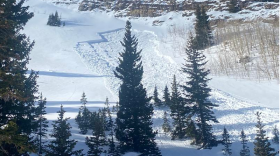Editor's note: This story was updated at 5:00pm February 4th, 2021 to add a future meeting date between Park City Mountain Resort and the U.S. Forest Service. The audio story is no longer current.
Last weekend’s deadly avalanche in the backcountry outside of Park City Mountain resort has prompted the closure of the backcountry access gates at PCMR until further notice. KPCW’s Sean Higgins has more on the current situation:
Last Saturday’s deadly avalanche in the Squaretop backcountry area claimed the life of 57-year-old Parkite Kurt Damschroder, an experienced backcountry skier who was familiar with the area.
According to the official accident report by the Utah Avalanche Center, both Damschroder and his ski partner had proper avalanche rescue gear at the time of the accident.
Saturday’s death was the second backcountry fatality in the Park City area within a month after a slide also claimed the life of 31-year-old Kevin Steuterman on January 8th. Steuterman and Damschroder both accessed the backcountry through the gates at PCMR.
PCMR does not patrol the backcountry and is not responsible for skiers and riders who use their chairlifts to access the backcountry.
The backcountry access gates at PCMR were initially closed on Saturday due to the incident and subsequent avalanche mitigation that took place in order to make the area safe for rescue crews to enter. However, the gates at PCMR remain closed.
Sources at PCMR have told KPCW the gates are rarely closed, and when they are, are due to an ongoing incident or investigation in the backcountry.
In a brief statement sent to KPCW by PCMR, Senior Communications Manager Jessica Miller said:
“In the aftermath of recent tragedies outside of our resort boundary, we have closed the backcountry access points until further notice.”
The backcountry access gates are located on private property owned by PCMR, and the decision to close them is solely up to the resort. That’s according to the US Forest Service’s Ben Kraja, who is the Winter Sports and Special Uses Program Manager for the Salt Lake ranger district.
“So the status of those gates is that they are solely on private property, on PCMR property,” said Kraja. “It’s really a decision within PCMR. A lot of folks think PCMR is permitted under a special use permit like Alta, Snowbird, Brighton, and Solitude, but that’s not the case. PCMR is private property, so they do not have a permit on US Forest Service land.”
Kraja said the Forest Service is schedulet to meet with the resort Tuesday, February 9th and added he would like to see access to public land maintained, but understands the access points remain on PCMR’s property.
Utah Avalanche Center Forecaster Trent Meisenheimer said the center has reported over 50 avalanches over the past eight days. With more new snow in the forecast, he says the danger is not letting up anytime soon.
“You know, it’s just not gonna go anywhere,” he said. “Unfortunately, like we’ve been saying over and over this winter, it's just going to be a dangerous one. Even if you see tracks on a slope, it in no way does it mean it’s safe out there. All you really have to do is find the right spot on the slope, you’ll collapse the slope, it will shatter like a pane of glass, you’ll look to your left, you’ll look to your right, but there will be nowhere to run. The avalanche you just triggered will likely be two to five feet or deeper and hundreds of feet wide and likely unsurvivable.”
Meisenheimer added that the best way to avoid an avalanche is to stay out of the backcountry. If you do head out, the Utah Avalanche Center urges skiers and riders to stick to terrain that is under 30 degrees in steepness and well clear of other steeper, more avalanche-prone terrain.
The complete avalanche accident report can be found here.






